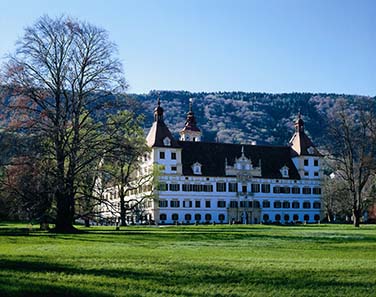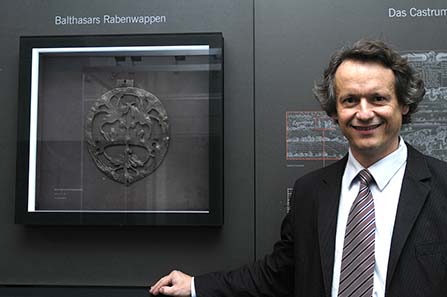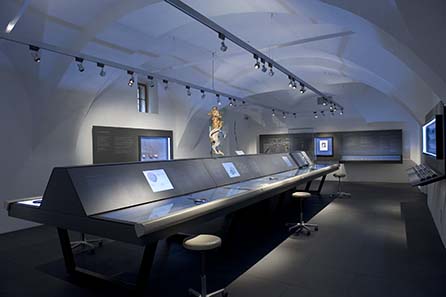June 24th, 2010 – Remarkable and historic coins from the magnificent panther thaler minted in Graz to the monetary crisiscausing schinderling groat, from the coined medallions of Flavia Solva to the pure Renaissance jewelled medallion of Archduke Karl II of Inner Austria: The numismatic collection of the Coin Cabinet at the Universalmuseum Joanneum has impressive stories to tell about the power and the powerlessness of money and has been thoroughly inspired by the location Schloss Eggenberg.
Schloss Eggenberg. © UMC.
New presentation in the oldest part of the castle: the ”Castrum Eckenperg”
The Coin Cabinet provides broad glimpse and a powerful reflection of the Joanneum coin collection in its entirety and has also been inspired by the castle location in the very hear of Schloss Eggenberg. The platform for the display is in two rooms both in the oldest part of the castle dating from the second half of the 15th century and named in Latin documentary sources as Castrum Eckenperg. This was the original structure in the princely residence.
The ”Balthasar Eggenberger” Exhibition Room
The ”Balthasar Eggenberger” Room – named after its builder, the richest citizen of Graz in the late middle ages – provides an insight into the life of this financial tycoon, who laid the foundations for the rise of the House of Eggenberg. During the 1450s Balthasar became financier to Emperor Friedrich III and was appointed Master of the Graz Mint. His contemporary Jakob von Unrest describes these times in his Chronicle of Austria: ”The emperor permitted bad coins to be struck and these were called “schinderlings”. Anyone who had a lot of old copper kettles could strike much better ones. He permitted the minting of these coins … to a citizen of Graz named Eggenberg. He had the lease of the imperial mint. The controllers, mint masters and mint journeymen became great and wealthy men.”
Mag. Karl Peitler, head of the coin cabinett at Joanneum, presents the exhibition. © UMC.
The ”Hans Ulrich von Eggenberg” Exhibition Room
Hans Ulrich von Eggenberg was the great-grandson of Balthasar and the prime minister of Emperor Ferdinand II. This was the Eggenberger, under whom the construction of the princely residence was begun in 1625. This remarkable and highly educated man who rose to be one of the most influential princes in the Holy Roman Empire within the course of a few decades lends his aura to the atmosphere of the second exhibition room. The coins on display in this room provide an account of the coins produced and those in circulation in Styria from antiquity through until the end of the 18th century. Impressive treasure finds and selected coins that have been found as single pieces illustrate the position of Styria in the interregional monetary systems since Celtic times. Selected coins from the Graz mint also show the kind of work that was done at this centre for the striking of coins and minting of money and that was in operation from about 1215 for about 500 years until its closure in 1772 by the Empress Maria Theresa.
A glimpse into the exhibition. © UMC.
The thaler ruled monetary developments until the end of the 19th century and it also represented the high water mark in the significance of the coin monetary system. Thaler coins were minted in Graz from 1574 to 1765. It is above all the large surfaces of these coins that are so impressive and many examples are a magnificent witness to the highly developed art in the cutting of the mint stamps. The Münzkabinett in the Universalmuseum Joanneum possesses virtually 80% of all the varieties of coin and all the years that were minted in Graz. The absolute highlights of this unique series are the panther thalers of Archduke Karl II, the triple thaler of Emperor Ferdinand II and his son Ferdinand III, as also rare clipped coins and the last Styrian thaler that was minted under the reign of the Empress Maria Theresa.
It was the practice of the local rulers in the Holy Roman Empire from about the 1560’s on to cast medals in honour of subjects who had performed some special service as a mark of favour and to place both the image and the motto of the ruler on these medals. These medals were regarded as precious decorative items and hung as symbols of office on gold chains. A medal struck in 1567 by the Italian medallion maker Antonio Abondio for the Archduke Karl II of Inner Austria is one of the most treasured exhibits in the Coin Cabinet at the Universalmuseum Joanneum. The portrait on the head side shows the ruler bearded and gazing to the right wearing long curly hair and a lace collar his upper body in ceremonial armour, and wearing a sash.
The final portion of the collection is that of the coins and medals of the Eggenberg family. As a special mark of imperial favour in 1625 Hans Ulrich von Eggenberg was awarded the freedom ”that he and the descendants and heirs of the Prince of Eggenberg may mint all types of gold and silver coins, both large and small, gross with admission to the imperial coinage with lettering, images, coats of arms and imprints on both sides of these coins.” Unlike his ancestor Balthasar, Hans Ulrich and his descendants were permitted to place their own image on the coins. Coins issued by the Engenderers are today considered to be particularly valuable rarities by collectors.
Schloss Eggenberg with its princely palace, baroque formal presentation rooms, its medieval chapel and romantic landscaped park with planet garden is today the most important stately home in Styria. It houses other Universalmuseum Joanneum collections as the Universum der Kunst – the universe of the arts: these include the Alte Galerie of old masters, the archaeological collection and the Lapidarium.
If you want to know more about “Universalmuseum Joanneum”, click here.
For the Coin Cabinet, click here.
| Coin Cabinet Schloss Eggenberg Eggenberger Allee 90 A-8020 Graz Apr-Oct, Tues-Sun 10am-6pm, Nov-Mar, Tues-Sun 10am-5pm Information: +43-316/58 32 64-9513 |







